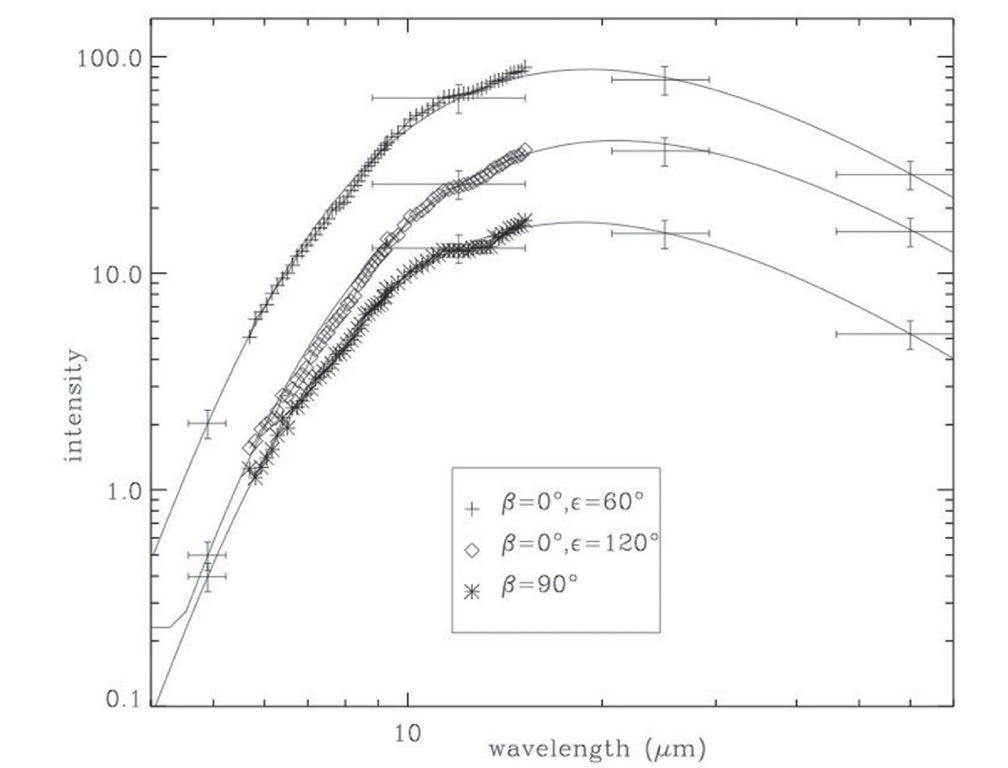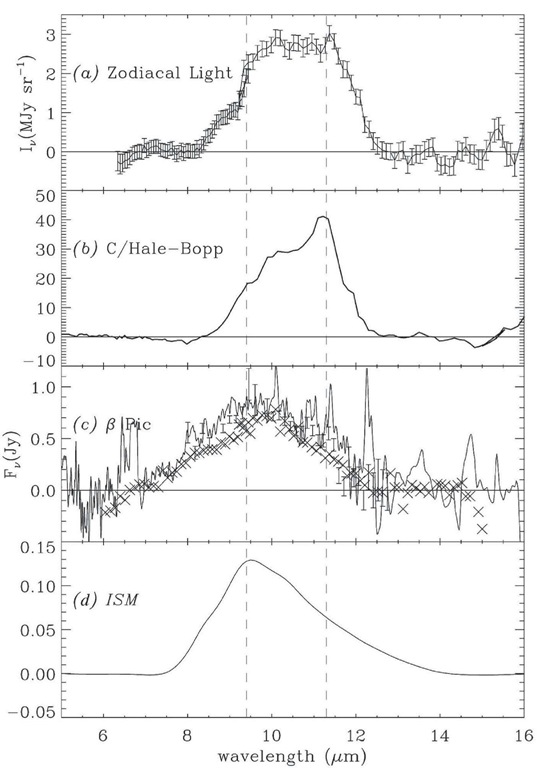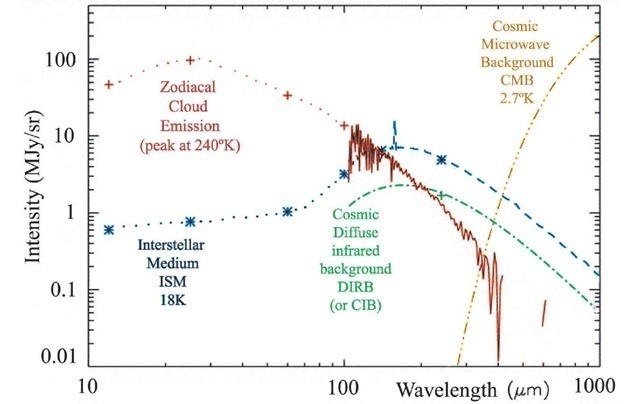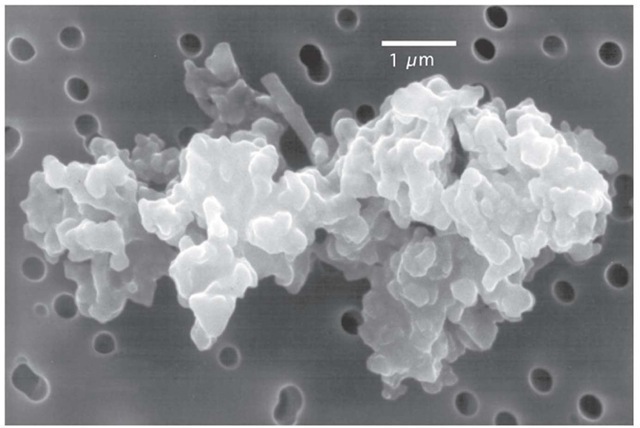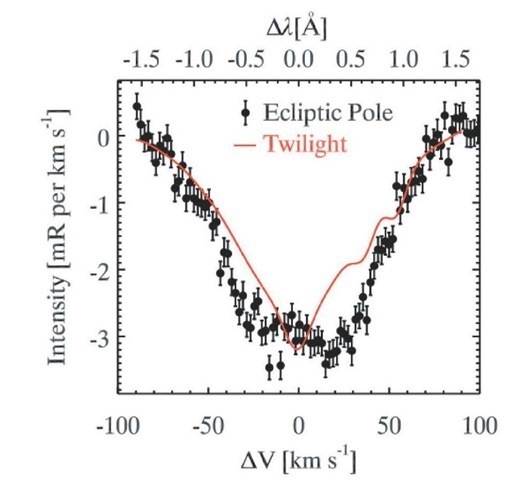ISO (Infrared Space Observatory) data
In spite of its faintness in optical wavelengths, the Zodiacal Light is the dominant source of the medium-infrared sky brightness as seen from the Earth. The cross-over point is at a wavelength around 3.5 microns; at wavelengths shorter than this, the major part of the energy is scattered sunlight (with Doppler-absorption lines) – and at longer wavelengths the spectrum is dominated by thermal emission of dust grains. One of the most interesting parts of the whole spectrum is in the mid infrared (between 5 and 16 microns wavelength range), where the surface brightness increases by two orders of magnitude. In addition to the practical importance of characterising this steep rise in intensity, this is the spectral regime to look for spectral signatures of the materials constituting the small dust grains – emission lines which can be simulated in the laboratory, and then recognised in the observations of the ZL. The general shape of the mid infrared spectrum is relatively well-determined now (Abraham et al 1997). Very little is known, however, of the variation of spectral shape over the sky. These variations may arise from temperature differences within the Interplanetary Dust Cloud, or from differences in dust composition and size distribution in different viewing directions. Leinert et al (2002) analysed 29 ISO/ISOPHOT spectra distributed over the accessible sky, in order to search for variations in the spectral shape. ISO carried two separate instruments, ISOCAM (with a resolving power of 40, and wavelength range 5-16 microns), and ISOPHOT (resolving power 95, wavelength range 5.9 to 11.7 microns). At such low resolutions, Leinert et al found that the observed spectral range was smooth and featureless, and could be fitted by black body radiation with colour temperatures in the range of 255-300 Kelvin. The variation in temperatures was modelled by geometrical distribution of dust in the inner Solar System. From their results they concluded that the present-day interplanetary cloud is well-mixed in terms of grain composition and size distribution. Later, in 2003, Reach et al (2003), observed the Zodiacal Light spectrum, this time with ISOCAM, in a wide range of orientations relative to the Sun, aiming to determine whether there was a silicate feature in the ZL, and whether there were spatial variations in its spectrum. They found radiation consistent with a cloud of particles of sizes 10 to 100 microns, and they did detect a ‘weak feature’ which they attributed to a mixture of silicates, more dominant at low elongations from the Sun than further out (see Figure 1.13, overleaf).
Reach et al were able to make a comparison between our Sun’s ZC infrared emission spectrum and the emission from the first exo-zodiacal cloud discovered, Beta Pictoris. The similarities and differences, along with comparisons also with spectra from comet Hale-Bopp and interstellar dust, are illustrated in their diagram, shown in Figure 1.14 (overleaf). Noting the wider ‘plateau’ in the emission feature in (a), and the shape of the peaks in (b) and (c), it may be reasonable to theorise that ‘b + c = a’, and the feature seen here in the Zodiacal Cloud comprises elements from cometary material and interstellar material.
Figure 1.13 From Reach et al (2003). Ratio of the observed Zodiacal Light spectra to a black body continuum. The continuum was fitted using only wavelengths outside of 9-11 microns.
This supports my proposition (sections 1.4.4 and 4.11) that radial velocity measurements may indicate a significant interstellar component in the dust which produces the optical Zodiacal Light.
COBE (Cosmic Background Explorer)
In 1989, the COBE satellite was launched, following the IRAS strategy, into a Sun-synchronous Earth orbit, moving in a plane which remained almost perpendicular to the direction of the Sun. It had two infrared detecting instruments on board: the DIRBE (Diffuse InfraRed Background Experiment), which had a 0.7° by 0.7° field of view pointing 30° off axis, looking at 10 infrared bands in the range 1.25 to 240 microns; and the FIRAS (Far Infrared Absolute Spectrophotometer), which had a 7° diameter field of view, pointing along the spin axis, and was sensitive to long wave infrared up to 1,000 microns. IRAS had made the discovery of the inclination of the axis of the main smooth ZC to the ecliptic, plus three sets of narrow dust bands, and a circumsolar ring at 1 AU, with a concentration of dust just behind the Earth. Kelsall et al (1998), using data from DIRBE, derived a detailed spatially varying Zodiacal spectrum in the 1.25-240 micron range and mapped the complex geometrical structure of the ZC, the purpose being to subtract the Zodiacal contribution and accurately measure the remaining cosmic DIRB.
Figure 1.14 From Reach et al (2003). Continuum-subtracted spectra of (a) the Zodiacal Light, (b) Comet Hale-Bopp (Crovisier et al 1997), (c) the Beta Pictoris disc, and (d) interstellar particles (Draine and Lee 1984).
Fixsen and Dwek (2002), combining the measurements from the two COBE instruments, built up an annually averaged infrared spectrum of the ZC spanning a huge range of wavelengths. At the lower wavelengths they found a ZL spectrum indicative of a black body at about 240° K; but at 150 microns, they found a sharp break, which they attributed to a cut-off at around 30 microns radius, which for particles predominantly composed of silicates, corresponds to a mass of 3.3 X 10-7g. They estimated the total mass of the Zodiacal Cloud to be 2-11 times 1018 g, requiring a replenishment rate of 1014 grammes per year. The spectrum of the components of emission in the night sky which Fixsen and Dwek (2002) derive is most informative.
Figure 1.15 is adapted from their figure, which shows that around the area of the break in the Zodiacal dust spectrum, the Galactic Interstellar Medium (ISM) and the DIRB near peak intensity, but beyond about 500 microns the CMB (cosmic microwave background, echoes of the Big Bang) becomes completely dominant. This dominance continues all the way up to 5cm wavelength!
Collected samples and in situ measurements
Interplanetary dust particles of sizes 1 micron to 1 millimetre have been collected from the Stratosphere, polar ice, and from deep sea sediments (Jessberger et al 2001). By direct laboratory examination, it has been discovered that typically the particles are black, porous, and have a chondritic composition. They are complex mineral aggregates, sometimes known as ‘fluffy’, a mixture of large numbers of sub-micrometer sized components. One such particle, collected from the Stratosphere, is illustrated in Figure 1.16.
Figure 1.15 From Fixsen and Dwek (2002). Overview of the spectrum of the night sky in the entire range of the infrared.
These individuals are believed to be reasonably representative of the population of IDP’s in the vicinity of the Earth’s orbit. The smallest survive unmelted because of their low entry speeds in the atmosphere, and only moderately altered by their capture and residence on Earth. One feature distinguishing these finds as a group is that they contain large abundances of noble gases, having been exposed to the solar wind and cosmic rays for a long time. Helium and Neon as well as many spallogenic isotopes are found, confirming their origin outside the Earth. Not all of the particles are fluffy – a few are smoother, but of similar composition. By measuring the abundances of two different isotopes of Oxygen in such particles, Keller et al (2003), ascertained that typically just one of the many tiny particles making up a fluffy IDP was of interstellar origin … the so-called Stardust. Determination of the mechanism of the capture of such a grain is a challenge! The current opinion is that the origin of IDP’s has not been firmly ascertained.
Pioneers 8 through 11, Helios, Galileo, and Ulysses space probes measured interplanetary dust in situ from 0.3 to 18 AU distance from the Sun (Gran et al 2001). The consensus is that within 3 AU the particles orbit the Sun at low inclinations (less than 30 degrees), and their orbits are moderately eccentric (eccentricity less than 0.6).
Figure 1.16 From Jessberger et al (2001). A porous chondritic IDP collected from the Stratosphere.
The measured dust flux displays a 100-fold decrease in density from the orbit of Mercury to that of Jupiter. In addition, particles in highly eccentric orbits have been recorded in the inner Solar System. The so-called Beta-Meteoroids are predicted to leave the Solar System on unbound hyperbolic orbits, accelerating because of the action of solar radiation pressure. Where did they come from … ?
Interstellar dust
One of the great ‘surprises’ in space observations, as noted by Sykes et al (2004), was that the detectors on board the space vehicle Ulysses, once past the orbit of Jupiter, began to register particle impacts from the opposite direction to that expected from interplanetary dust particles, and at high velocities, clearly indicating an interstellar component to the dust cloud, which predominates at these distances from the Sun, but has been now detected, by the Hiten detector, even at 1 AU (Gran et al 1993). If my interpretation paper had been published as planned around 1975, this discovery might have been less of a surprise! This is the source of both satisfaction and frustration to me, from the position I occupy in 2007, but a full discussion of the possibility of an interstellar component of the ZC, mirroring my writings in 1974 based on our measurements, will be offered in topic 4.
Grogan, Dermott and Gustafson (1996) estimated that the contribution of interstellar dust flowing into the Solar System was small – but the conclusions of Landgraf et al in 2000 were somewhat different. By attributing all collected particles with impact directions not attributable to elliptically orbiting dust, and speeds in excess of the local escape velocity to an interstellar component, they inferred a flux of interstellar grains with masses > 10-14 kg of 10-6 m-2 s1. This is therefore an estimate of the dust density in the Local Interstellar Cloud (LIC). Confirmation of the interstellar component has also come from other quarters. Particles moving in hyperbolic orbits have been detected in ‘AMOR’ ground-based radar measurements by Baggaley (2000) of meteors, of limiting particle radius 20 microns. It also appears that these particles have unusual origins, to say the least – Baggaley (2000) apparently saw evidence for influx from the direction of Beta Pictoris, well-known for possessing its own ‘zodiacal cloud’! Landgraf et al (2000), combining Radar estimates with in-situ measurements, found a flux for interstellar particles of mass greater than 10-14 kg , of 10-6 m 2 s1 . I will return to this discussion in section 4.11.1.
Doppler measurements and models since 1974
Doppler shift radial velocity measurement was taken up again in 1978, by Fried (1978), using a different type of instrument – a correlation mask radial velocity spectrometer. This ingenious device, first devised and described by Griffin in 1967, correlates the Doppler-shifted spectrum under study with an unshifted reference spectrum, using a photographically produced optical mask, and gives a single output, recorded by a single detector, in which the information on radial velocity content is immediately available. Fried found no difference in the magnitudes of radial velocities found in morning and evening. He also concluded from his data that the orbital velocities of the dust particles were in excess of those for elliptical Keplerian orbits, and that particles within 0.7 AU of the Sun were moving at speeds greater than the escape velocity (see section 4.13.1).
After my period of experimentation was completed, it was some years before our own Doppler-Shift based line of inquiry was continued, in a 3-year experiment, by my former supervisor Ken Reay and I. R. East, using a spectrometer of improved stability, and their further results were published in Astronomy and Astrophysics (East and Reay 1984). They confirmed the morning-evening asymmetry found in my observations, and found the material of the Gegenschein to be receding from us at 2.5 m/s. They found no evidence to support the results or conclusions of Fried: in particular they did not support the idea of hyperbolic orbits. For detailed discussion, see section 4.13.2.
After another 10-year period of little activity in the radial velocity field, the subject was revisited by Clarke et al (1995). They presented a more rigorous theoretical model of the ZC, and included the full quantum mechanical scattering function of the particles, as successfully used by Hong (1985) in purely photometric predictions, to predict the detailed shape of the absorption line. They concluded that asymmetries should be seen at high resolution, revealing the fine structure of radial velocities. In particular they offered an interpretation of the F-Corona observations of Beavers et al (1980), who recorded double minima in their absorption line spectra. No observations were published following on from these new predictions.
Thereafter, the line of Doppler-shift experiments seems to have lapsed, until the quest was taken up by Reynolds et al (2004). Their technique, using the Wisconsin Hydrogen Alpha Mapper (‘WHAM’) Fabry-Perot spectrometer attached to a 0.6 metre telescope, with a one-degree field of view, and a resolved width of 12 km/s (equivalent to 0.2 A) was immediately much more powerful than our small light-gathering coelostat and filter-limited Fabry-Perot etalon. Their results have greatly reduced the error bars on the ‘Radial Velocity (= wavelength shift) versus Elongation’ graph, and they have been able to employ them in comparison with modern sophisticated models of the ZC with great effect. Interpretations of these new data were published by Ipatov et al (2006). Using measurements with rather better signal-to-noise than we were able to achieve, and higher resolution, this team have attempted to extract other parameters from the spectral curves to supplement the radial velocity estimations; they have been the first observers since my experiment to measure the behaviour of the width of the line with elongation (see topic 4). They also obtained spectra out of the ecliptic plane; an example is shown in Figure 1.17.
Their observations are compared with new theoretical curves calculated by Ipatov et al (2006). Their models compute actual spectra pertaining to a line of sight, and are based on evolutionary theories of the Zodiacal Cloud (Ipatov and Mather 2005); rather than simply starting with an arbitrary set of orbital elements for the dust particles, Ipatov et al go back a step to scenario in which about 15,000 asteroidal, cometary, and trans-Neptunian particles begin a journey through the Solar System.
Figure 1.17 From Madsen et al (2005). Spectrum of the twilight sky (red) and the Zodiacal Light toward the North ecliptic pole (circles), centred near the MgI 5183.6 angstrom line.
They compute the paths of these objects over time, under the influence of Poynting-Robertson drag, solar wind drag and the gravitational disruptions of the planets, and freeze the aggregate to obtain predictions of the Doppler shifted spectrum resulting from a line of sight. One of the most important parameters which controls the dynamical behaviour of dust particles is P (not to be confused with the ecliptic latitude parameter P0). P is defined as the ratio of the Sun’s radiation force to the gravitational force on the particle, and typically has values from 0.0004 to 0.4 in these Zodiacal Cloud models. It has the value P = 0.573Qpr /(ps), where p is the density, s is the particle diameter, and QPR (not to be confused with Queen and Paul Rodgers) is the radiation pressure coefficient, which is close to unity for particles larger than one micron. For silicates of density p = 2.5g/cm3 the values of P 0.004, 0.05, and 0.4 correspond to partic le diameters of about 120, 9.4, and 1 micron respectively. Evidently if P becomes equal to or greater than unity, the particle will be swept out of the Solar System. This is the basis for the assumption that the ZC does not contain significant numbers of particles less than 0.3 microns in diameter. Particles in exactly this balanced state of force will be able to drift through the Solar System without interference from the Sun; however they will experience perturbations from the planets! I will return to this idea in the ‘continuous flow’ model discussed in topic 4.
I will revisit the ‘WHAM’ recent findings in topic 5, and will be able to compare their findings with my measurements of 30 years earlier.
It is a remarkable circumstance for me that, after a period of relative neglect of almost 30 years, this line of inquiry, Doppler measurements of the ZL, should become active again, at the very moment when I have been able to return to the field. In the final topic of this thesis I will outline current plans to take this study further in the near future.
